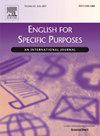The case of English for aviation maintenance: A multi-dimensional analysis of commercial aircraft manuals
IF 2.7
1区 文学
Q1 LINGUISTICS
引用次数: 0
Abstract
Aircraft manufacturers use Simplified Technical English (STE) as a strategic tool to enhance the readability of aviation maintenance manuals and reduce comprehension errors. This standardized linguistic approach is essential for ensuring global aviation safety, especially as approximately 80% of maintenance technicians worldwide are non-native English speakers (NNES). This study employs Biber's Multi-Dimensional analysis framework (Biber, 1988, 1995, 2006) to investigate the linguistic characteristics of aviation maintenance English (AME) compared to general written English (GWE). The research is based on a 27-million-word corpus derived from maintenance manuals for all operational Boeing commercial aircraft families (737, 747, 757, 767, 777, and 787), which collectively serve over 150 countries and represent nearly half of the global fleet (Boeing, 2024). The analysis reveals that AME prioritizes informational density, minimizes abstract content, and uses comparable levels of elaboration to ensure clarity in safety-critical contexts. These findings challenge the misconception of simplified English as overly simplistic or reductive, demonstrating instead that strategic linguistic simplification enhances technical communication without compromising clarity. By highlighting the role of STE in supporting global interoperability, safety, and efficiency, this research offers valuable implications for English for Specific Purposes (ESP) pedagogy and the ongoing development of STE guidelines in aviation and other high-stakes industries.
航空维修英语案例:商用飞机手册的多维分析
飞机制造商使用简化技术英语(STE)作为提高航空维修手册可读性和减少理解错误的战略工具。这种标准化的语言方法对于确保全球航空安全至关重要,特别是因为全球大约80%的维修技术人员是非英语母语者(NNES)。本研究采用Biber的多维分析框架(Biber, 1989,1995,2006)来研究航空维修英语(AME)相对于通用书面英语(GWE)的语言特征。该研究基于2700万字的语料库,这些语料库来自所有波音商用飞机系列(737、747、757、767、777和787)的维护手册,这些飞机总共服务于150多个国家,占全球机队的近一半(波音,2024年)。分析表明,AME优先考虑信息密度,最小化抽象内容,并使用可比较的细化级别来确保安全关键上下文中的清晰度。这些发现挑战了人们对简化英语过于简单或简化的误解,相反,战略性的语言简化在不影响清晰度的情况下提高了技术交流。通过强调STE在支持全球互操作性、安全性和效率方面的作用,本研究为特殊用途英语(ESP)教学法以及航空和其他高风险行业的STE指南的持续发展提供了有价值的启示。
本文章由计算机程序翻译,如有差异,请以英文原文为准。
求助全文
约1分钟内获得全文
求助全文
来源期刊

English for Specific Purposes
LINGUISTICS-
CiteScore
5.70
自引率
8.00%
发文量
41
审稿时长
62 days
期刊介绍:
English For Specific Purposes is an international peer-reviewed journal that welcomes submissions from across the world. Authors are encouraged to submit articles and research/discussion notes on topics relevant to the teaching and learning of discourse for specific communities: academic, occupational, or otherwise specialized. Topics such as the following may be treated from the perspective of English for specific purposes: second language acquisition in specialized contexts, needs assessment, curriculum development and evaluation, materials preparation, discourse analysis, descriptions of specialized varieties of English.
 求助内容:
求助内容: 应助结果提醒方式:
应助结果提醒方式:


